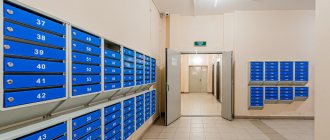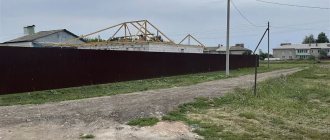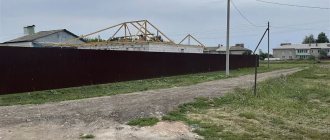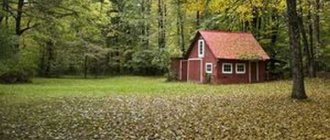What is common property in MKD
When a person buys an apartment in a multi-apartment building, he acquires not only the housing itself, but also part of the common property belonging to all residents.
This property includes:
- premises that are not parts of apartments and are intended to serve more than one residential or non-residential premises in a given building. These are inter-apartment landings, stairs, elevators, elevator and other shafts, corridors, strollers, technical floors, attics, basements with utilities, garbage chutes and garbage receptacles;
- roofs;
- enclosing load-bearing structures of the house. These are foundations, load-bearing walls, floor slabs, balcony and other slabs, load-bearing columns;
- enclosing non-load-bearing structures of a house serving more than one room. These are windows and doors of common areas, railings, parapets;
- mechanical, electrical, sanitary and other equipment (including to ensure unhindered access for people with disabilities) that serves more than one room;
- automated information and measurement systems for accounting for the consumption of utility resources and services, if they are installed at the expense of the owners of premises in the apartment building;
- the land plot on which the house is located, with elements of landscaping and landscaping, as well as other facilities located on this plot for the maintenance, operation and improvement of the house (transformer substations, heating points serving one house, collective parking lots, garages, children's and sports grounds in boundaries of the land plot). A land plot is included in the common property if its boundaries and size are determined in accordance with the requirements of land and town planning legislation;
- other premises in the house that do not belong to individual owners and are intended to meet the social and everyday needs of residents. These are premises intended for organizing leisure time, cultural development, children's creativity, physical education and sports, etc.
Common property in an apartment building belongs to the owners on the right of common shared ownership. The share is proportional to the size of the total area of the apartment.
Category classification
Based on the definition of a public place, the following category classification was formed:
- Permanent. Access to these places is open all the time: alleys, streets, boulevards, train stations, squares, squares, embankments, courtyards. The exception is the courtyards of private territories.
- Periodic. These premises are intended for recreation and serving the population at specific hours. Among them are markets, medical, health and educational institutions, entertainment, cultural, sports structures, recreation areas, public transport, trading establishments, passenger compartments (at night), train cars for passengers (in addition to vestibules), a dining car and a toilet.
Who should take care of common property?
Common property in an apartment building must be maintained in proper form:
- staircase landings must be clean;
- the equipment must work properly;
- The lights should be on and the motion sensors should be activated.
The property is in good condition, if it complies with sanitary and technical standards, it can be safely and comfortably used for its intended purpose.
Requirements for the condition of common property
- The property must meet the characteristics of reliability and safety
- Common property should not pose a threat to the life and health of citizens
- The person responsible for the condition of the common property must ensure access to residential and non-residential premises, common areas, as well as to the land plot (including for disabled people and other groups of the population with limited mobility)
- When using common property, the rights and legitimate interests of the owners of the premises must not be violated
- The person responsible for the condition of the common property must ensure the constant readiness of utilities, metering devices and other equipment included in the common property to provide utilities to residents of the apartment building
- In the case of construction or reconstruction of an apartment building, the architectural appearance of the building must comply with the design documentation
- The common property of apartment buildings must comply with the requirements of legislation on energy saving and increasing energy efficiency
Usually, to maintain the property in proper condition, residents create a homeowners' association (HOA) or enter into an agreement with a management organization (MA).
Also, owners with direct management can independently enter into agreements with specialized organizations. In addition, the developer has the right to maintain the property in proper condition if he did not transfer part of the premises to other persons after receiving permission to put the apartment building into operation, or the person who accepted the premises from the developer under the transfer deed.
General understanding of the term
Since the enforcement of articles of the Code of Administrative Offenses regarding drinking alcoholic beverages and petty hooliganism occurs quite often, it is advisable to formulate a more precise definition of a public place. The importance of detailed wording (or rather, its absence) becomes absolutely clear if we take into account that a mandatory condition for the use of Articles 20.1 and 20.20 of the Code of Administrative Offenses is considered to be the commission of violations specifically in public areas. Next, we will consider the essential characteristics and features of a publicly accessible site.
The definition of a public place implies a lack of regard for personal property. For example, a country house or someone’s apartment cannot be recognized as such. A similar conclusion can be made about entertainment and shopping complexes, because these areas have an owner, and they themselves are considered private property. The definition of a public place under the Code of Administrative Offenses allows for the appearance of different people in it, both in groups and individually, as a rule, at any time of the day.
What is included in the maintenance of common property*:
- inspection of common property to timely identify non-compliance of property with the requirements of the legislation of the Russian Federation, as well as threats to the safety of life and health of citizens;
- ensuring the readiness of in-house engineering power supply systems and electrical equipment to provide public electricity supply services;
- maintaining temperature and humidity in common property areas;
- cleaning of common areas and land plots as part of common property;
- collection and removal of liquid household waste, including waste from organizations and individual entrepreneurs using non-residential premises in apartment buildings;
- organization of places for accumulation and accumulation of used mercury-containing lamps, their transfer to specialized organizations that, under a license, work with waste of I-IV hazard classes;
- maintenance of municipal solid waste accumulation sites**;
- ensuring fire safety measures;
- maintenance of land plots with elements of landscaping and improvement;
- carrying out routine repairs, preparing for seasonal operation and maintaining common property, as well as landscaping elements on a land plot as part of common property;
- carrying out mandatory measures to save energy and improve energy efficiency;
- ensuring the installation and commissioning of common house metering devices for cold and hot water, thermal and electrical energy, natural gas, as well as their maintenance and verification of metering devices;
- purchase of cold and hot water, electrical energy for general house needs (GDN), as well as wastewater disposal.
* Depending on the composition, design features, degree of physical wear and technical condition of the common property, as well as depending on the geodetic and climatic conditions of the location of the apartment building.
** Does not include cleaning of municipal solid waste loading areas.
All owners of premises in an apartment building bear the burden of expenses for maintaining common property. The share of mandatory expenses for maintaining common property is also determined by the share in the right of common ownership of common property: the larger the area of the apartment, the higher the maintenance fee.
Responsibility for the safety of common property lies primarily with the property owners themselves, as well as the management organization they hired or the created HOA and local government bodies.
Features of a public place
So, we have looked at the definition of a public place and the category of offenses committed in the relevant territories. It is advisable to move on to the features of these areas.
For example, a construction site, which is fenced and guarded by a guard, is not considered a public place according to the definition of the Republic of Belarus, since it does not imply the appearance of people not related to the construction process there. According to a similar criterion, publicly accessible areas include city streets, parks, public gardens, staircases, and courtyard areas. The appearance of people in these areas does not require special approvals or permits. A person has every right to go there of his own free will at any time.
How can you use common property?
By decision of the general meeting of owners (GMS), property in an apartment building can be transferred for use to other persons if this does not violate the rights and legitimate interests of citizens and legal entities. For example, you can rent out the premises to a store, a consumer services company, or a children's development center. In this case, all owners in the apartment building will be the lessors.
The owner of premises in an apartment building does not have the right to:
- to allocate in kind your share in the right of common ownership of common property in an apartment building;
- sell or lease your share in the right of common ownership of common property in an apartment building, as well as perform other actions entailing the transfer of this share separately from the right of ownership of the apartment;
- carry out work and perform other actions that cause damage or spoil public property;
- rearrange or change the layout of common areas without the consent of all residents and the availability of documents that permit this. For example, without a decision from the OSS, you cannot install an additional door in a common corridor, especially if it impedes access to firefighting equipment.
Relevant offenses
From the total number of offenses that are committed by definition in public places, it is advisable to single out street offenses, in other words, those committed in socially developed areas. We are talking about streets, boulevards, squares, embankments, alleys, bridges, unfenced courtyards (with the exception of private courtyards). In addition, violations can be implemented in forested areas, residential areas, within urban settlements, public gardens, recreation areas, on beaches, stadiums, and markets during operation.
Communal payments
Payment for utilities is also borne by residents in proportion to their shares in the apartment. For example, if accounting devices (meters) are not installed in the premises, the parties must decide among themselves on what principle they will divide the payment - according to the occupied area or the number of residents. Each case has its own nuances and not everyone is comfortable and correct what is for others.
In the case where there are metering devices, the rules do not need to be changed. It is unlikely that anyone will use a meter to track exactly how much resource they spent and calculate the total amount at the end, although this option is not excluded.
When neighbors cannot reach a solution peacefully and go to court, the decision will be as follows: gas, heating and water are divided by the number of people living, and electricity is calculated according to the installed appliances in the rooms.
Russian legislation does not regulate obligations regarding the division of payment for utilities in a communal apartment, but there are penalties for non-payers. Personal accounts can be divided so that each resident owner is responsible for their own payments, but in practice not everyone does this. Accordingly, if one neighbor does not pay and the bills are not divided, everyone will be held responsible, even those who pay their share.
Final part
So, we have fully considered the category of public territory. As it turned out, the current law does not define this term in any way. Nevertheless, some regulations define the characteristics that characterize such an ambiguous concept. Therefore, most lawyers believe that this definition requires serious improvements. It is also necessary to create the clearest possible interpretation. The fact is that it is for violations in public areas that people are brought to administrative responsibility.
In a general sense, a public place should be understood as an area where people can suddenly appear at any time of the day. We are talking, for example, about a bus stop, a playground, a park, educational, medical, entertainment institutions, exhibition complexes, public transport, as well as other government structures and those areas where the population is served. Since in practice, law enforcement officers quite often charge individuals for drinking alcohol, smoking and behaving indecently in crowded places, it would be absolutely useful to include a certain formulation of the concept in question in the Code of Administrative Offenses.
It is worth remembering that among the signs of a publicly accessible territory, the main ones are the following: the unhindered appearance of people, in other words, they can come to these places absolutely suddenly; holding persons administratively liable even for minor hooligan acts, as well as smoking and drinking alcohol. Therefore, a public territory, the definition of which is not enshrined in the current legislation in Russia, should not be called someone’s private dacha, house, garage, building for only one extremely simple reason: all this is the personal property of citizens, and it is illegal to enter there without the invitation of the owners.
Controversial issues
If the inclusion of the objects listed above under the definition of a public place according to the law of the Republic of Belarus is absolutely clear and, as a rule, does not raise questions, then the classification into the category, for example, of staircases, one way or another, requires explanation. So, on the one hand, the entrances or staircases of apartment buildings are often deprived of the possibility of unauthorized individuals entering them without obstacles. However, if someone decides, for example, to drink alcoholic beverages in the entrance, then the neighbors will almost certainly notice.
It turns out that in such places the rights of strangers can potentially be violated. By the way, it is for this reason that both entrances and staircases of apartment buildings are also included in the category of public places. Infrastructure facilities in terms of transport are considered the most important component of publicly accessible areas. It is advisable to include here not only stops and stations, but also transport itself.
As for the last case, it is worth recalling the following: hooliganism that is insignificant relative to the current law is qualified under Article 20.20 as carried out in a public place, regardless of whether it was carried out, for example, in a train carriage or at a station.








